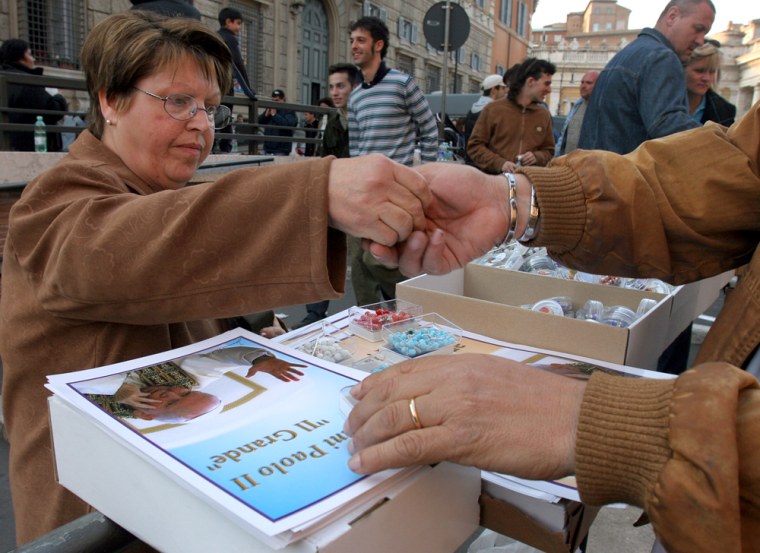With up to 4 million pilgrims pouring into the city to pay their respects to Pope John Paul II, businesses hope for an unseasonable windfall worth millions of dollars — but some say profits could be disappointing.
City officials, storekeepers and business owners complained Wednesday some of the profit is going to unlicensed street vendors — selling water, food or papal trinkets, for instance— and said stores that are not near the Vatican are almost empty.
These are not the high-rolling spenders who wander through the ancient ruins or museums of the Eternal City. These are pilgrims who don’t go to restaurants, take cabs or tourist trips around Rome.
But their sheer numbers are bound to translate into a business boon.
So many are coming for Friday’s funeral that the city is offering free cots at tent camps erected on a fairground, in an unused railway building and inside a concert hall.
“This is a type of tourism that is eat-and-run,” said Franco Cioffarelli, the city’s financial chief. “It certainly brings in money, but I don’t think this is a relevant phenomenon financially.”
The consumer monitoring group Codacons disagreed, estimating businesses would earn an additional $122.5 million over two weeks.
It said visitors were expected to spend $193.4 million just on transportation — trains, plane tickets and gasoline.
Those estimates were based on a conservative figure of 2 million pilgrims. Since then, the crowd estimates have gone up.
A Codacons spokesman said 10 to 20 percent of the revenue was probably going to illegal businesses.
Though Cioffarelli had not estimated the potential earnings, he acknowledged the flow of people was unprecedented. The Chamber of Commerce said it also had no financial estimates.
Although Rome’s streets are jammed with visitors, taxi companies said they aren’t earning that much. “These people go on foot a lot,” said Paolo Pombi, of the Pronto Taxi company. Still, he added, “when there is high tide, a few fish are going to fall in your lap.”
Shopkeepers around St. Peter’s said their best-selling items are small and cheap images of the pope — pictures, postcards, but also magnets, key chains and medals.
The visitors are prey to vendors and storekeepers selling goods at double the price or more, city officials said. Inspectors found about 10 percent of the hundreds of premises they visited were gouging their customers, said Col. Giuseppe Zafarana of Italy’s financial police.
“The closer you get to the basilica, the higher the prices,” Cioffarelli said.
Codacons issued a warning to visitors through the Italian media with tips to avoid getting fleeced. It recommended filling empty water bottles at public drinking fountains, leaving the Vatican area for meals, buying snacks at grocery stores before going to St. Peter’s and demanding receipts at all times.
Inspectors found that prices of small bottles of water fluctuated from $1.50 to $3.25.
Codacons estimated earnings of $64.4 million from the sale of religious articles, including rosaries and images and small statues of saints; $25.8 million from restaurants, bars, cafes and grocery stores, and $32.2 million from hotels.
But some complain they are missing out, especially those out of range of the Vatican.
And in some cases, shops near the Vatican said they have been blocked by police barricades controlling the flow of people viewing the pope’s remains.
“We are completely cut off,” said Luigi Bernardi, standing in an empty store on Via della Conciliazione, the street that leads to St. Peter’s Square, watching the crowd walk by. “We take place at ceremonies for the pope’s death, but not in any commercial way.”
